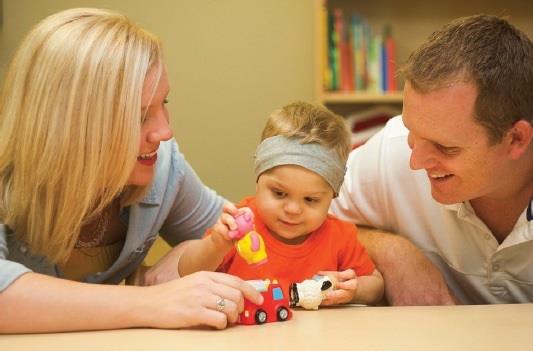Blog
-

Thirty Million Words
 12 Aug , 2016
12 Aug , 2016
Thirty Million Words by Dana Suskind, PhD, is a must-read for all families of children with hearing loss and the hearing health care professionals who serve them. Early in her career as a pediatric cochlear implant surgeon at the University of Chicago, Dr. Suskind was troubled by the variability in the spoken language and listening outcomes achieved by the children for whom she provided cochlear implants.
She opens the book by recounting the stories of Zach, her second patient with a cochlear implant, and Michelle, her fourth. Both children were born deaf, had no additional disabilities, and received a cochlear implant at about 12 months of age. Suskind celebrated the fact that Zach was a loquacious third-grader who read at grade level, had age-appropriate listening and spoken language skills, and excelled in a classroom of children with normal hearing. On the other hand, she lamented her encounter with Michelle in a Chicago classroom of children with hearing loss. Michelle was completely unable to communicate through spoken language and only had a limited sign language vocabulary.
Why did the cochlear implant provide near miraculous benefit for Zach and seemingly no benefit for Michelle? Bewildered by the stark differences in these outcomes, Suskind embarked on a quest to learn how two children with similar potentials could achieve such dissimilar results. Thirty Million Words describes her journey to identify the reasons behind these different outcomes and her pursuit of solutions that will ensure positive outcomes for her future patients.
Suskind reached out to a large group of researchers at the University of Chicago in an effort to better understand the variability in language development outcomes of children with both normal hearing and those with hearing loss. Additionally, she audited Dr. Susan Goldin-Meadow’s undergraduate class, Introduction to Child Language Development. Goldin-Meadow lectured on the classic language acquisition research of Chomsky and Skinner, but Suskind was particularly intrigued by the work of child psychologists Betty Hart and Todd Risley. Like Suskind, Hart and Risley were interested in the wide range of vocabulary levels of children entering kindergarten. More specifically, the researchers sought to better comprehend the reasons that children from affluent homes had substantially greater language and vocabulary development at 5 years of age than their counterparts from impoverished homes. Hart and Risley initially aimed to improve the outcomes of children from impoverished homes by creating the Juniper Gardens Children’s Project, a program that provided vocabulary-enriching pre-school education to 4-year-olds in an attempt to prepare them for success in kindergarten and beyond. Although the children in this program showed initial surges in vocabulary and language development, the gains did not persist over time, and the Juniper Gardens participants showed little to no benefit from the program when they enrolled in kindergarten. Discouraged but not defeated by this finding, Hart and Risley decided that the explanation for the differences observed in kindergarten must be determined prior to pre-school age, so they focused their attention on the development of children throughout the first three years of life.
Hart and Risley took on the gargantuan task of conducting intensive observations of the daily routines of families across all socioeconomic classes throughout the first three years of their children’s lives. Through this study, they discovered what many consider to be one of the most significant research findings in the history of early childhood development. Hart and Risley found that children from affluent, professional families heard 45 million words by their fourth birthday, while children from families receiving welfare assistance heard 13 million words during the same period—noting a difference of 32 million words between these two groups. The essential factor that determines language development in kindergarten, Hart and Risely found, was a child’s early language environment—how much and in what manner a parent spoke to and with a child.
Upon hearing the results of the Hart and Risley study, one may ask, “Is it really necessary for a family to have money for a child to optimally develop vocabulary and spoken language?” Fortunately, the answer is a resounding “NO!” Hart and Risley found that even within socioeconomic groups, children exposed to a larger number of words developed larger vocabularies and greater language skills. In other words, the children from impoverished families who heard more intelligible speech throughout the first three years of life developed better language skills than their peers who were exposed to fewer words. Likewise, the affluent children who developed the greatest language abilities were from families who talked the most. Furthermore, in an independent study of the language development of children from families with low incomes, Dr. Anne Fernald also found a significant relationship between a child’s early language environment and the child’s eventual vocabulary development and language abilities. In short, the research unequivocally indicates that a child’s receptive and expressive vocabulary and language development is directly related to his/her exposure to intelligible speech. The more words a child hears, the greater his receptive and expressive vocabulary will be. The number of words a child hears directly impacts her spoken language skills.
Hart and Risley observed another important phenomenon. They found that childhood language outcomes were not only dependent on the quantity of words to which a child was exposed, but also to the quality of the interaction between the parent and child. Specifically, children who were exposed to affirmative feedback (e.g., positive and supportive language) achieved greater vocabulary and language abilities than children who were subjected to parent-initiated imperatives (e.g., prohibitions and admonishment such as ‘Don’t,’ ‘Stop,’ ‘Get out of there,’ etc.)In the study, parents who spoke in affirmative and positive tones were more likely to engage in “extra talk” and spontaneous back-and-forth chit-chat that Suskind describes as the “icing on the cake.” For example, these parents were more likely to use this language: “Let’s take off this stinky diaper, sweet baby! Whew! Stinkeeeeee! I’m glad we got that wet diaper off of my beautiful, sweet baby. Now let’s clean you up. Ooh, I am sorry the wipe is so cold. Poor baby! I love you. Your daddy loves you. Your grandma loves you. Now let’s powder you up! We are almost finished.” Some mothers speak in melodic tones while changing a baby’s diaper, which results in even greater engagement of the language areas of the baby’s brain. This “serve and return” sets the stage for future conversational turn-taking and is paramount to healthy bonding, social-emotional development, and, of course, receptive and expressive language development.
In contrast, parent-initiated imperatives often result in a dearth of language exposure. While changing a diaper, the parent might say, “Stop crying.” After the diaper is changed, the parent might then say, “All done. Now go on!” It is clear that affirmative feedback results in a far more enriching world of intelligible speech. Neuroscientists have learned that the brain develops optimally when children are consistently exposed to nurturing and supportive environments. However, when a baby is exposed to stress, the brain is bathed in “stress hormones, such as cortisol. As a result, the architecture of the brain is permanently altered resulting in behavior problems, health issues, and learning difficulties.But there is good news! When parents were encouraged to talk more, Hart and Risley noted that the quality of the caregivers’ language improved. According to Hart, we do not have to necessarily train parents to talk differently. “We just have to help them talk more,” and the rest will take care of itself.Obviously, a child with hearing loss is at risk for hearing less than 45 million words by his/her fourth birthday.
Suskind quickly associated the Hart and Risley findings with the disparate outcomes of Zach and Michelle. Zach was raised in an affluent family who made certain he attended all audiology and therapy appointments and consistently used his hearing devices during all waking hours. According to Suskind, Zach’s domestic environment included a great deal of talking, reading, and singing. In contrast, Michelle’s family struggled to meet even their most basic needs of food, shelter, safety, and clothing. Michelle frequently missed audiology appointments and did not attend therapy. Presumably, she also did not consistently use her cochlear implant as it would be difficult for the family to afford batteries for her sound processor. Although Zach and Michelle represent extremely different cases, children with hearing loss are at risk for delayed language and vocabulary development because of restricted access to intelligible speech secondary to their hearing loss.Children with severe to profound hearing loss typically must wait until at least 6 months of age to receive a cochlear implant.
Clinical audiologists are faced with the daunting challenge of determining ear-specific and frequency-specific hearing thresholds during the first few weeks of life to ensure that the child gets the most appropriate hearing technology. Fortunately, our field is equipped with an excellent set of protocols that serve as a guide in facilitating accurate assessment of auditory function in infants (see previous Tot 10 columns). Pediatric audiologists must also ensure that hearing aids and cochlear implants are optimally programmed to meet a child’s individual auditory needs, and all hearing health care professionals must impart upon the family the importance of full-time use of hearing technology. Furthermore, the use of remote microphone technology will undoubtedly increase access to intelligible speech for infants and children with hearing loss.The implications of the Hart and Risley study extend far beyond vocabulary and language. They also reported that children who had been exposed to more words during their first few years of life had higher I.Q. and test scores at 3 years of age and later.
As one might expect, these children also enjoyed greater levels of success in the classroom. Dr. Dale Walker reevaluated the children in the Hart and Risley study and found that early language exposure predicted language abilities and educational test scores at 9 and 10 years of age. Suskind also notes that children who heard more words during their early years developed better reading skills. She offers an excellent explanation for the connection between spoken language development and reading abilities.
We must end by reaffirming our affinity for Thirty Million Words. Professionals working with infants and children with hearing loss should read this book and share its valuable messages. We encourage our readers to also join the TMW initiative in seeking to bridge the 32 million word gap.
Source: Copyright © 2016 Wolters Kluwer Health, Inc.
Image credit: The Hearing Journal. 69(8):16,17,18,20, August 2016.





























































































































































































































































































































































































































































































































































































